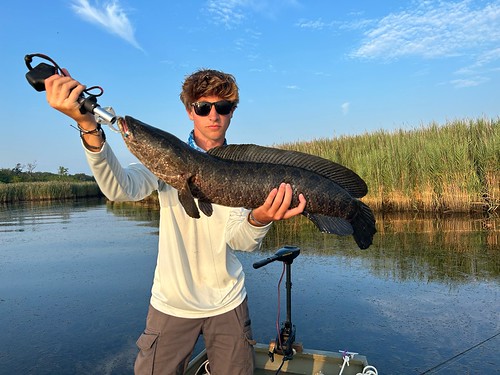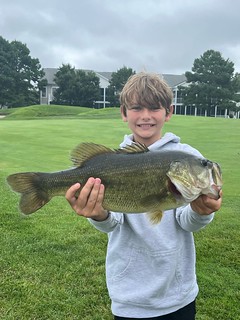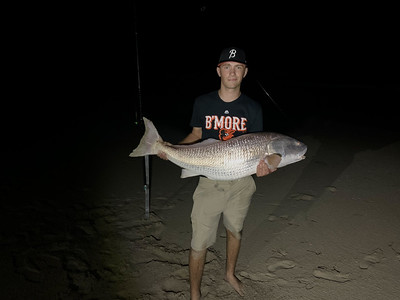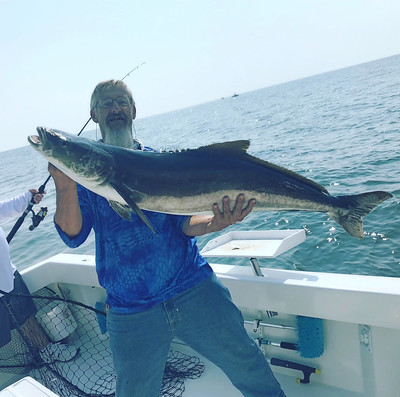Maryland Fishing Report – August 9

Jake Prior holds up a big northern snakehead he caught in an upper Bay tidal river. Photo courtesy of Jake Prior
Fishing is good this week in all parts of the Chesapeake Bay, the Atlantic Ocean and Coastal Bays, and the many freshwater areas throughout the state.
Maryland Department of Natural Resources’ biologists are looking to better understand the striped bass recreational fishery in the Chesapeake Bay and are asking for your help. Biologists have set up an online survey site where anglers can enter fishing data from a smartphone or computer. All you need to record is the length of the striped bass you catch and whether you kept or released them. On the department website, search for volunteer angler surveys to find the striped bass survey and others that may interest you. For ease of use, you can also access the surveys through the free AccessDNR app.
Forecast Summary: August 9 – August 15:
While recent rains have cooled Bay surface waters, a combination of sunny conditions and another chance of thunderstorms on Thursday and Monday should keep water temperatures stable in the low 80s. The coolest main Bay surface waters continue to be found between the Patapsco River and Annapolis.
Bay salinity is still above average. Throughout Maryland Bay waters, oxygen conditions are better this week with most places recording suitable fishing depths down to at least 25 feet. Check the areas of low oxygen map to help determine the maximum fishing depth in your favorite area.
Expect average flows all week, although local thunderstorms may increase flows in nearby waters. There will be above average tidal currents Saturday through Tuesday as a result of the upcoming new moon August 16. Expect average clarity in Maryland’s waters. To see the latest water clarity conditions, check Eyes on the Bay Satellite Maps.
As always, the best fishing areas could be further refined by intersecting them with underwater points, hard bottom, drop-offs, and large schools of baitfish.
For more detailed and up-to-date fishing conditions in your area of the Bay, be sure to check out Eyes on the Bay’s Click Before You Cast.
Anglers in the Conowingo Dam pool and lower Susquehanna River are enjoying fishing for striped bass in the early morning and evening. The dam is on an afternoon-evening power generation schedule so a refreshing surge of cool water flows through the dam pool and the lower river at these times. Popular choices for fishing them include casting topwater lures before sunrise and after sunset, and using jerkbaits, crankbaits, soft plastic jigs, and paddletails.
Striped bass fishing picked up right where it left off at the mouth of the Patapsco River . Anglers are using spot for live-lining with good success during the morning. There is also action at the Key Bridge and north to Pooles Island. Jigging is a good option along the channel edges and near the Key Bridge piers. Farther up the Patapsco near the commercial piers there is good topwater lure action at dawn. There has also been good striped bass fishing by live-lining and jigging at the Love Point rocks.
Spot suitable for live-lining can be found in Curtis Creek, the mouth of the Magothy River, close to shore at Podickory Point, off Sandy Point State Park, and at the shallower west end of the Bay Bridge. In most of these areas white perch will also be part of the mix when fishing bottom rigs baited with pieces of bloodworm or artificial bloodworm-scented baits.
White perch can be found in all upper Bay tidal rivers and can be caught fishing with grass shrimp, pieces of bloodworm, peeler crab, or small minnows when fishing in deeper waters. During the early morning and late evening, casting roadrunner lures, small spinnerbaits, or jigs is a fun way to catch white perch.
Blue catfish provide plenty of fishing opportunities and can be found in the tidal rivers and the uppermost parts of the Bay. Fishing the bottom with fresh cut bait of menhaden is the most popular way to find them, and other bait options can work well also.

Bong and Jung Bae went fishing at the Bay Bridge with their son, who photographed them with two nice striped bass they caught. Photo by Moo Bae.
Striped bass are being caught on the east side of the Bay Bridge at the 30-foot drop-off. The fish are holding tight to the bridge piers during a good running tide. Drifting with live spot, small white perch, or soft crab baits works well. The best action is during the early morning, and then slacks off as the sun rises in the sky; the late evening also provides good fishing.
Much of the better striped bass fishing in the middle Bay occurs early morning or late evening in the shallower waters along the Bay and tidal river shorelines. The rocks along Poplar Island and Thomas Point are also good places to cast topwater lures or paddletails. Speckled trout, bluefish, and puppy drum are also a welcome addition to the mix being caught.
Bluefish can be found throughout the middle Bay this week; along the edges of the shipping channel and the False Channel area, Spanish mackerel can be mixed in with them. The shipping channel edge from Buoy 83 south past the Sharps Island Light is a very good place to target Spanish mackerel this week. When trolling, a mix of bright-color Drone Spoons or gold Clark spoons behind No. 1 planers at 7-8 knots is the best way to target them.
Watching for diving gulls can lead to exciting topwater action wherever a mix of bluefish and Spanish mackerel are feeding on schools of bay anchovies. Casting small but heavy metal jigs or Got-Cha lures into the fray and speed-reeling is a fun way to catch Spanish mackerel, and slower retrieves will invite bluefish to strike.
White perch continue to offer plenty of summer fun fishing off docks and piers and on the shorelines of the Bay and tidal rivers. Grass shrimp, pieces of bloodworm, peeler crab, or small minnows are great baits to use on a simple bottom rig when fishing deeper waters close to structure. During the early morning and late evening, casting roadrunners, beetle-spins, and small spinnerbaits near shoreline structure is a fun way to catch white perch on light tackle. Chartreuse and silver Clouser minnows cast on a 5-weight fly rod is another great way to enjoy the action.
Anglers fishing for striped bass are finding them along the shorelines of the lower Bay and tidal rivers, the shallower waters. This is an early morning or late evening affair for those casting topwater lures, jerkbaits, and paddletails. Speckled trout, bluefish, and puppy drum are also part of the mix, especially on the Eastern Shore. The main stem of the Potomac River remains closed to striped bass fishing until August 20, but anglers can fish the Maryland tributaries, such as the St. Marys River. Virginia waters do not open to striped bass fishing until October 4.
Bluefish can be found throughout the lower Bay and can be caught in a variety of ways. Most are being caught by trolling or by casting into breaking fish. Often the bluefish can be found mixed in with Spanish mackerel. If you are lucky, diving gulls can mark the way to breaking fish where bay anchovies are being pushed to the surface. Casting small but heavy and flashy metal jigs into the action and letting them sink a bit before retrieving is a great way to get into the bluefish and Spanish mackerel. Approach carefully from the upwind side of the action and quietly drift into casting range. A fast retrieve will catch the attention of the Spanish mackerel, and a slower retrieve will attract bluefish.
Trolling is an excellent way to cover water along the shipping channel edges when searching for Spanish mackerel. Trolling with small Drone Spoons of various colors and gold Clark spoons behind No. 1 planers at speeds of 7 to 8 knots is the best way to attract the attention of Spanish mackerel. As with retrieves when casting, slower speeds will allow bluefish to catch up. Smith Point and the HS Buoy are good places to troll this week.
Fishing for spot is very good in the lower sections of the tidal rivers, with the lower Patuxent River a standout. White perch will also be part of the mix, and they can be found in the many creeks and rivers within the lower Bay.
Large red drum continue to frequent the area around the Target Ship, the Mud Leads and the Middle Grounds. At times they can be found under breaking Spanish mackerel and bluefish, and other times slicks and churned-up water can indicate their presence. Jigging with large soft plastics or dropping soft crab baits will entice them for some exciting catch-and-release action.
Cobia can be found near Smith Point and near the Target Ship; there are not many to be found but it only takes one legal-sized cobia to make your day. Most anglers are chumming and fishing with live eels in the back of their chum slicks.
Recreational crabbing can be a hit-and-miss game but is providing some excellent crabs in many areas. The largest crabs tend to be coming from waters 10 feet to 15 feet deep. Shallow depths of 6 feet or so also have good crabs but many are small.

Adam Martin caught and released this beautiful largemouth bass at a small pond. Photo by Keith Martin
To better facilitate fishing for invasive blue and flathead catfish, the Department of Natural Resources has instituted a regulation change regarding cut bait in non-tidal waters. Anglers will now be able to use cut bait of fish, such as bluegill sunfish, with no minimum size restrictions. There is a maximum of two pounds of cut bait allowed in an angler’s possession.
Also, plan ahead for March 2024 as Maryland is introducing a new youth-only trout fishing day ahead of the traditional trout opening day in certain state-managed waters, where anglers under the age of 16 will be able to catch and keep two trout. Look for details on the department website and in future announcements.
For now, freshwater anglers are enjoying the summertime passion of fishing quiet ponds, reservoirs, and tidal waters this week. Largemouth bass are usually the target for most anglers but a mix of chain pickerel, bluegill sunfish, and crappie can also be found.
Northern snakeheads are in various stages of spawning and protecting fry balls of their young. They can be found in the shallows in thick grass. Casting buzzbaits, chatterbaits, and soft plastic frogs can often annoy them enough to strike. They are not feeding but will protect their young from perceived threats, so it may take more than one cast to get them to strike.

Angler Zachary Winkler caught and released a 49-inch red drum at Assateague Island. Photo courtesy Zachary Winkler
Surf anglers are catching a mix of kingfish and spot on bloodworms and artificial bloodworm baits. The best fishing is occurring during the early morning. Bluefish can be caught on finger mullet. At night large red drum continue to be caught and released, as are a mix of inshore sharks.
At the Ocean City Inlet, sheepshead are being caught on sand fleas near the jetties and the Route 50 Bridge piers. Bluefish and striped bass are being caught on soft plastic jigs and by drifting cut bait. In the back bay channels flounder fishing has been good during the top of the flood tide and the beginning of ebb.
Fishing for sea bass, triggerfish, and flounder continues to be good at the wreck and reef sites. At the canyons, a mix of bigeye and yellowfin tuna are being caught. Small dolphin are being caught near the lobster buoys and any floating debris. Blueline and golden tilefish are being caught at the canyon edges.
“Angling is a tightly woven fabric of moral, social, and philosophical threads which are not easily rent by the violent climate of our times.” – A.J. McClaine
Maryland Fishing Report is written and compiled by Keith Lockwood, fisheries biologist with the Maryland Department of Natural Resources.
Click Before You Cast is written by Tidewater Ecosystem Assessment Director Tom Parham.
This report is now available on your Amazon Echo device — just ask Alexa to “open Maryland Fishing Report.”



 1-888-373-7888
1-888-373-7888 233733
233733